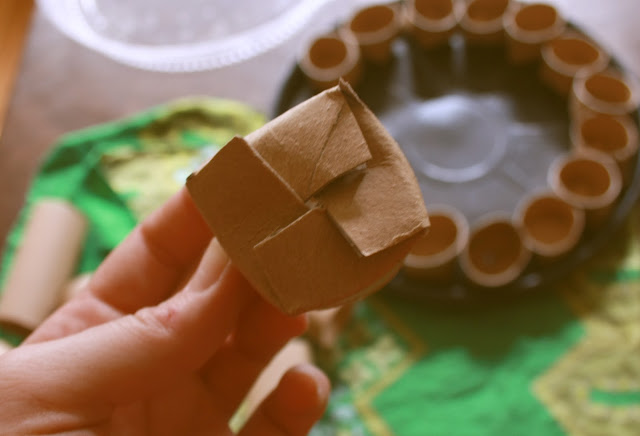 Cats:
Cats:- Buy refillable cat-litter. I know that Petco offers this. You buy a bucket full of litter. Then when it is empty you bring your bucket back, refill it, and they only charge you the refill price after the initial purchase.
- Another green option is to use compostable cat-litter and compost your cat's waste. There are several options which include sawdust, commercially made pine or cedar litter, wheat-based, and litter made from recycled newspaper. You should use a separate compost bin for this, and it is not recommended to use this compost on plants you will eat, but you could use it on other non-edible plants in your yard. Here's an article on composting pet waste.
- Check your local health food store for bulk cat food that you can put in your own container.
- Make your own toys. We made a toy out of a dowel rod with strips of an old t-shirt tied onto it. Also, for some reason Ravi kept stealing my scrubber sponges made out of coconut fibers, so I attached a feather onto one for him. Lasers are pretty fun, too.
- Make your own cat treats. There are lots of recipes on Pinterest. ;)

Dogs:
- When out on walks, use paper or newspaper to pick up their "business" instead of plastic bags.
- Again, research composting pet waste and if it would work for you.
- Look for bulk dog food.
- In the case of toys, Jolene, is very rough, I mean she shreds them. So I get heavy duty toys that will last a long time. I highly recommend the Kong line of toys; I put larger treats or peanut butter inside of these when we are leaving her alone for a while. Also, I recommend the Tuffy's Ultimate series toys; these are great for playing indoors because they are made of cloth. You can see in the picture she has torn this one up, but she has learned that if she doesn't destroy it she will get to keep it. It has lasted almost a year now. Both these brands of toys can be found at Petco. We also have a hard rubber toy, that we put smaller treats inside of, to keep her occupied.
- Be careful when using a laser to play with your dog. Jolene becomes obsessed with trying to figure out where it is coming from and whines and goes completely insane for a while. Haha. She only gets to see it in small doses.
- Make your own treats! Jolene loves these:

Sweet Peanut Butter Dog Biscuits
2 cups whole wheat flour
1 cup rolled oats
1/3 cup peanut butter
1 1/4 cup hot water
1 Tbsp. honey, molasses, maple syrup, or agave nectar
- Preaheat oven to 350° F.
- In a large bowl mix all dry ingredients.
- Add peanut butter and honey. Roughly mix then knead with your hands into a ball.
- Flour your counter and use a rolling pin to flatten the dough ball to 1/4 inch.
- Use a cookie cutter to cut into the shape your want. -OR- Use a pizza cutter to cut into squares. -OR- Bake it as a whole sheet and break apart after it is cooked.
- Spray your cookie sheet with cooking spray and place your biscuits on the sheet.
- Bake for 20-30 minutes, depending on your pet's desired crunchiness. :)
- Allow to cool. Store in the refrigerator in an airtight jar.
love & light,
Claire

.JPG)












.JPG)











